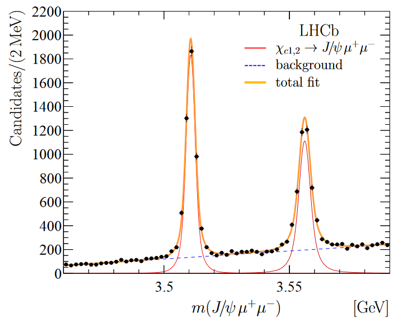[m(χc1) = 3510.71±0.04±0.09 MeV; m(χc2) = 3556.10±0.06±0.11 MeV]
[m(χc2) – m(χc1) = 45.39±0.07±0.03 MeV]
[Γ(χc2) = 2.10±0.20±0.02 MeV]
Today, at the open session of the Large Hadron Collider Committee, LHCC, the LHCb collaboration presented the result of a precise mass measurements of χc1 and χc2 mesons, performed for the first time by utilising the newly discovered decay χc1,2→μ+μ–J/ψ.
χc1, χc2 and J/ψ mesons belong to a family of particles that are commonly referred to as charmonium states. They are bound systems of a charm quark, c, and an anti-charm quark, c, held together by the strong nuclear force. Just like ordinary atoms, e.g. hydrogen, c and c quarks can be arranged in various quantum states with different angular momenta and spin configurations, giving rise to a spectrum of particles with different masses, all composed of the same fundamental quarks. The image on the left represents the complexity of this spectrum along with some of the allowed decay transitions as a function of mass (in the vertical axis) versus spin and other quantum numbers (in the horizontal axis). The decay paths corresponding to the decays under study are highlighted in red. The first charmonium particle, the J/ψ meson, was discovered on the 11th of November 1974. This discovery triggered rapid changes in high-energy physics at the time and these are commonly referred to as the “November Revolution”. The charmonium family was then intensively studied by a large number of experiments at different facilities. In particular, the masses of χc states were measured by studying radiative decays into J/ψ mesons, i.e. χc1,2→γJ/ψ, and later by using dedicated experiments employing collisions of protons and antiprotons for their production. As it is experimentally very challenging to measure the energy of a photon precisely in the harsh environment of a hadron collider, high-precision measurements have not previously been made at a collider like the LHC.
The new analysis from LHCb applies an old “trick” in a new situation. This technique was first proposed in 1951 by R.H. Dalitz to study the decay of the π0 meson, which had been discovered one year earlier. Decays of π0 mesons into two real photons were not easy to observe in the detectors used at the time. R.H. Dalitz realised that quantum mechanical fluctuations permitted one (or both) of the photons to be virtual, allowing them to transform into an electron-positron pair.
LHCb physicists observed the new decay χc1,2→γ*J/ψ where the virtual γ* transforms into a μ+μ– pair giving a rise to a χc1,2→μ+μ–J/ψ decay. The high precision of the LHCb spectrometer allowed two narrow χc peaks to be observed in the invariant J/ψμ+μ– mass with excellent resolution, as apparent in the right image above. The values of the masses of the χc1 and χc1 states, m, along with another important property of the χc2 called “natural width”, Γ, are measured through this novel decay. The new measurements have a similar precision to and are in good agreement with those obtained at previous dedicated experiments, notably E760 and E835, that used antiproton annihilations into a hydrogen target to produce and study the charmonium states (see the image below for a comparison amongst the various results available in the literature). This new measurement opens a new avenue to precision studies of the properties χc mesons at the LHC, more than 40 years after the November Revolution took place. It will facilitate a better understanding of quantum chromodynamics (QCD), i.e. the theory that describes the behaviour of the strong nuclear force.
More information can be found in the LHCb presentation and in the corresponding LHCb paper. Read more in the CERN update for the public and in the CERN Courier article.



